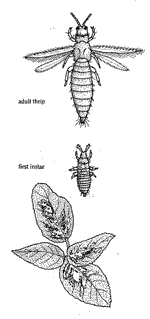 |
While thrips eat leaves they are a real nuisance because thrips attack flower blossoms. They ruin flower blossoms. You won't have an easy time spotting thrips, since they are only ;1/25 inch long; you can observe them by shaking infested flowers over a sheet of paper. What is readily visible are their dark fecal pellets and the whitened, desiccated tissue that results from their mass feedings. The insects are very active and hop or fly away like little bits of confetti when disturbed.
About Thrips
Adult females lay eggs on the leaves, fruit, or stems of plants. Nymphs hatch and begin feeding on the host plants. They will remain on the plant throughout adulthood. A generation of thrips is normally completed in about two weeks, and several generations occur in a year. Many species occur throughout North America. Thrips most often attack dry, stressed plants.
Emergence Time - Thrips are active in greenhouses throughout the year. Outdoors, they emerge from hibernation in the spring, and will find their way into greenhouses by early summer.
Symptoms of Thrips
The chief target of thrip attack is flower blossoms, especially white, yellow, and other light-colored blossoms. They rasp and puncture petals to feed on the juices, leaving flowers discolored and disfigured. Thrips will also feed on leaves, which become bleached and wither. Their damage to fruit scars the surfaces. New growth will be distorted. Heavy infestations destroy blossoms and leave foliage looking scorched.

